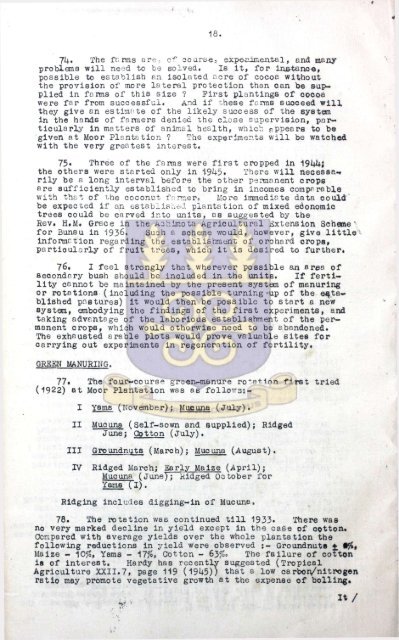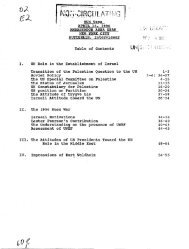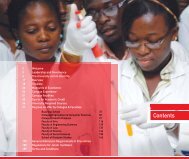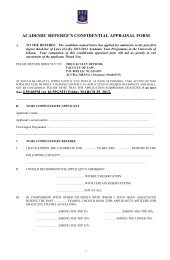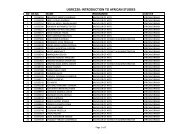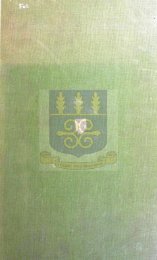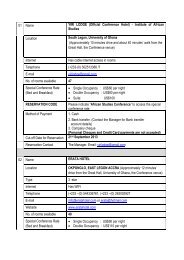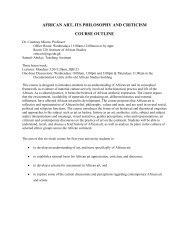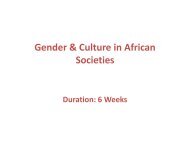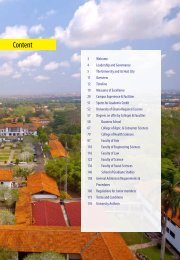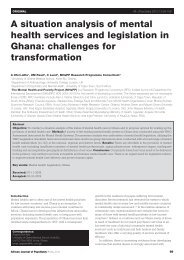View/Open - UGSpace - University of Ghana
View/Open - UGSpace - University of Ghana
View/Open - UGSpace - University of Ghana
- No tags were found...
Create successful ePaper yourself
Turn your PDF publications into a flip-book with our unique Google optimized e-Paper software.
18.74. The farms are- c^ coarse, expe-rJmexLtal, end manyproblems will need to be solved. Is it, for instance,possible to establish an isolated acre <strong>of</strong> cocoa withoutthe provision <strong>of</strong> more lateral protection than can be suppliedin farms <strong>of</strong> this size ? First plantings <strong>of</strong> oocoawere far from successful. And if these farms suoceed willthey give an estimate <strong>of</strong> the likely success <strong>of</strong> the systemin the hands <strong>of</strong> formers denied the close supervision, particularlyin matters <strong>of</strong> animal health, which appears to begiven at Moor Plantation ? The experiments will be watchedwith the very greatest interest.75« Three <strong>of</strong> the farms were first cropped in 1944}the others were started only in 1945. There will neoessa«»rily be a long interval before the other permanent cropsare sufficiently established to bring in incomes comparablewith that <strong>of</strong> the coconut farmero More immediate data could''be expected if an established plantation <strong>of</strong> mixed edonomlctrees could be carved into units, as suggested by theRev. H.M. Grace in the Achimota Agricultural Extension Scheme'for Bunsu in 1936, Such a scheme would, however, give littleinformation regarding the establishment <strong>of</strong> orchord crops,particularly <strong>of</strong> fruit trees, which it is desired to further.76. I feel strongly that wherever possible an area <strong>of</strong>secondary bush should be included in the units. If fertilitycannot be maintained by the present system <strong>of</strong> manuringor rotations (including the possible turning-up <strong>of</strong> the establishedpastures) it would then be possible to start a newsystem, embodying the findings <strong>of</strong> the first experiments, andtaking advantage <strong>of</strong> the laborious establishment <strong>of</strong> the permanentcrops, which would otherwise need to be abandoned.The exhausted arable plots would prove valuable sites forcarrying out experiments in regeneration <strong>of</strong> fertility,GREEN MANURING.77. The four-course green-manure rotation first tried(1922) at Moor Plantation was as follov.'3:-I Yams (November); Mucuna (July).II Mucuna (Self-sown and supplied); RidgedJune; Cotton (July).IllIVGroundnuts (March); Mucuna (August).Ridged March; Early Maize (April);Mucuna (June J"; Ridged October forYams Tl).Ridging includes digging-in <strong>of</strong> Mucuna,78. The rotation was continued till 1933. There wasno very marked decline in yield except in the case <strong>of</strong> cotton.Compared with average yields over the whole plantation thefollowing reductions In yield were observed :- Groundnuts •Maize - 10$, Yams - 17$» Cotton - 63$= The failure <strong>of</strong> cottonis <strong>of</strong> interest. Hardy has recently suggested (TropicalAgriculture XXII.7, page 119 (1945)) that a low carbon/ g°nn l t p oratio may promote vegetative growth at the expense <strong>of</strong> boiling.v.It/


